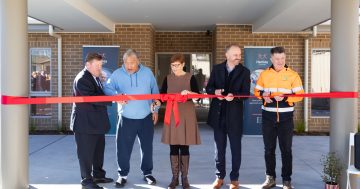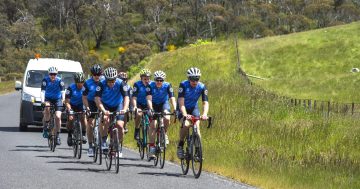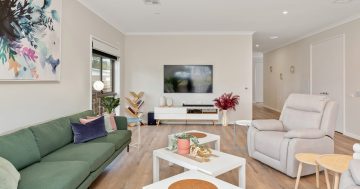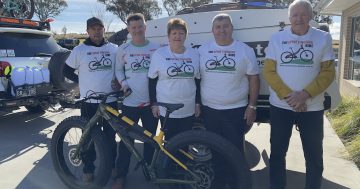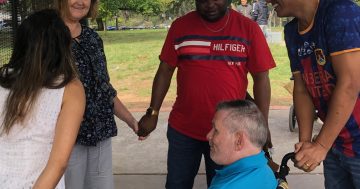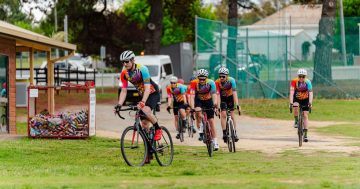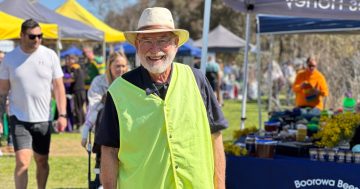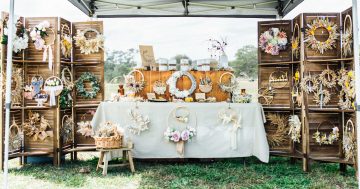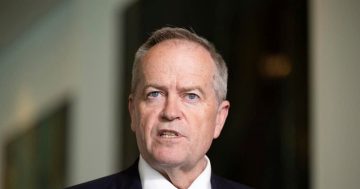
Residents, family and carers turn up for the Hartley Court sod turning. Photo: Michelle Kroll.
Over a decade since it was first earmarked for a complete rebuild, the sod has been turned on the new Hartley Court in Hughes.
One of the supported accommodation sites for people with disabilities, it’s owned by the not-for-profit organisation Hartley Lifecare.
There was a buzz in the air on Wednesday (5 April) as stakeholders met to officially break ground. Construction is set to begin this month and hopefully finish 12 months later.
Hartley Lifecare CEO Eric Thauvette said it was a big moment in what turned out to be a 12-year journey.
“It might be a strange thing to say, but it feels like we’re finally at the finish line when really, we’ve barely started,” he laughed.
“It’s incredibly exciting, and so invigorating for everyone moving in and their families. They’ve been very understanding of all the delays. But we’re here now.”

Time to build: Renaissance Homes owner manager Andrew Kerec, Hartley Court resident Minjae Chong, Hartley Lifecare board chair Lisa Keeling and CEO Eric Thauvette. Photo: Michelle Kroll.
Opened in 1984 on “a very tight budget and with incredible support from the community”, Hartley Court housed 11 people in three structures.
Mr Thauvette said the facilities were wonderful at the time, but age and wear meant they had become outdated and needed constant repair.
In 2011 he approached the board about extensive renovations or a complete rebuild.
“By then, there were much better models with better usage of space, hoist design and architectural design for people with high physical needs,” he said.
“The structure itself didn’t lend itself to retrofitting to meet current standards, such as widening the corridors. So the decision didn’t take long – we settled on a complete rebuild.”
Unfortunately, this wasn’t indicative of the pace of the rest of the project as planning and consultation with residents and their families began.
About half the board had lived experience with disability or were a family member of someone with a disability. The board created a sub-committee, comprising chair Lisa Keeling, a Hartley Court client and two other board members.
“That lived experience was critical to the decision-making process because we could hear specifically what it was like to need disability-specialised accommodation,” Ms Keeling said.
“From that we knew we wanted spaces where clients’ loved ones could visit, but in an environment where they could also receive the support they needed.”
But 2013 introduced the NDIS, which took over Hartley’s focus for the next five years, and the rebuild was put on hold.

Andrew Kerec (pictured with Lisa Keeling) secured materials at cost and pro bono work where possible for the build. Photo: Michelle Kroll.
In 2016 Hartley commissioned a feasibility study on the project, which estimated the costs at $2.6 million.
The final concept: two standalone houses at the back of the site and a block of four individual units at the front.
The idea: residents with high physical and complex needs could live in the main homes with the level of support required. Others needing a more independent supported living model would reside in the units at the front, with access to support from the main homes as required.

A momentous moment in a 12-year journey. Photo: Michelle Kroll.
The homes were designed with infrastructure to support high physical needs such as ceiling hoists and for ease of retrofitting as residents and needs changed. The latest in assistive technology would also allow residents to live as autonomously as possible.
But no sooner was the project approved, COVID hit.
And with it came the unprecedented hikes in construction labour and materials costs.
“Thankfully, builder Andrew Kerec from Renaissance Homes was keen to ensure adaptable and liveable houses in Canberra for people with disability,” Mr Thauvette said. “His father suffered a spine injury, so he understood the importance.
“Using his expertise and analysis of the market, he told us to wait until now, and it paid off.
“He also tapped into his network and called in all his favours to get materials at cost and pro bono work where possible to get us a build at a discounted cost.”
The existing structure was torn down in November and its residents rehomed while they wait to move back in.
“It’s been exciting to see this finally come to fruition. We’ve been talking about it since I joined the board,” Ms Keeling said.
“The purpose of Hartley is to ensure people with disability have the opportunity to live their best lives … we all know how our space and the way we live can change our quality of life.
“We can’t wait to deliver this project. It fundamentally aligns with our mission.”
Once Hartley Court is complete, it will own a total of five homes and four units.
Hartley Lifecare also provides support in 34 Canberra homes, offering 24-hour care and respite for people with disability. It supports more than 100 Canberrans with disability.
For more information visit Hartley Lifecare.












